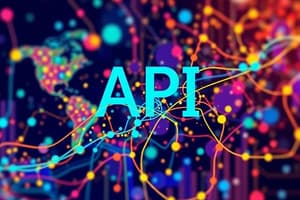Podcast
Questions and Answers
What does API analysis primarily focus on?
What does API analysis primarily focus on?
- Monitoring network traffic patterns
- Managing server infrastructure
- Analyzing user demographics
- Examining the structure, functionality, and behavior of APIs (correct)
Which of the following is a common type of API analyzed?
Which of the following is a common type of API analyzed?
- Hardware device drivers
- Database management systems
- Web APIs like REST and SOAP (correct)
- Operating system kernels
What is a key benefit of analyzing API documentation?
What is a key benefit of analyzing API documentation?
- Improving server hardware performance
- Understanding the intended use and functionality of the API (correct)
- Enhancing database security protocols
- Optimizing network routing configurations
Which of these is a common tool used for API analysis?
Which of these is a common tool used for API analysis?
What type of issues can be identified through API analysis?
What type of issues can be identified through API analysis?
What does traffic analysis primarily involve?
What does traffic analysis primarily involve?
Which technique is used in traffic analysis?
Which technique is used in traffic analysis?
What is the purpose of flow analysis?
What is the purpose of flow analysis?
Which tool is commonly used for packet capture and analysis?
Which tool is commonly used for packet capture and analysis?
What can traffic analysis be used to detect?
What can traffic analysis be used to detect?
What does API traffic analysis combine?
What does API traffic analysis combine?
What can API traffic analysis help identify?
What can API traffic analysis help identify?
What is a benefit of monitoring API traffic?
What is a benefit of monitoring API traffic?
What type of tool can be used for API traffic analysis?
What type of tool can be used for API traffic analysis?
Why is API traffic analysis crucial for organizations?
Why is API traffic analysis crucial for organizations?
What does packet sniffing involve?
What does packet sniffing involve?
What is the purpose of flow monitoring?
What is the purpose of flow monitoring?
What does log analysis help identify?
What does log analysis help identify?
What is the goal of security auditing?
What is the goal of security auditing?
What is a use case for API and traffic analysis?
What is a use case for API and traffic analysis?
Flashcards
API Analysis
API Analysis
Examining the structure, functionality, and behavior of APIs to understand how software systems interact and exchange data.
Traffic Analysis
Traffic Analysis
Monitoring and examining network traffic to gain insights into network behavior, performance, and security.
API Traffic Analysis
API Traffic Analysis
Combining API analysis and traffic analysis techniques to monitor network traffic generated by API interactions.
Packet Sniffing
Packet Sniffing
Signup and view all the flashcards
Flow Monitoring
Flow Monitoring
Signup and view all the flashcards
Log Analysis
Log Analysis
Signup and view all the flashcards
Protocol Analysis
Protocol Analysis
Signup and view all the flashcards
Payload Inspection
Payload Inspection
Signup and view all the flashcards
Behavioral Analysis
Behavioral Analysis
Signup and view all the flashcards
Endpoint Monitoring
Endpoint Monitoring
Signup and view all the flashcards
Security Auditing
Security Auditing
Signup and view all the flashcards
Performance Testing
Performance Testing
Signup and view all the flashcards
Fuzzing
Fuzzing
Signup and view all the flashcards
Wireshark
Wireshark
Signup and view all the flashcards
Postman
Postman
Signup and view all the flashcards
Swagger
Swagger
Signup and view all the flashcards
API Governance
API Governance
Signup and view all the flashcards
Capacity Planning
Capacity Planning
Signup and view all the flashcards
Anomaly Detection
Anomaly Detection
Signup and view all the flashcards
Web Application Firewalls (WAFs)
Web Application Firewalls (WAFs)
Signup and view all the flashcards
Study Notes
API and Traffic Analysis
- Understanding how applications communicate and monitoring network traffic is essential.
API Analysis
- API analysis examines the structure, functionality, and behavior of APIs.
- It facilitates understanding how software systems interact and exchange data.
- API analysis is applicable to web APIs like REST and SOAP, mobile APIs, and internal APIs.
- Analysis includes examining endpoints, request/response formats, authentication, and data schemas.
- Tools include Swagger, Postman, and specialized platforms.
- Analyzing API documentation helps understand the API's functionality.
- Security vulnerabilities, such as injection flaws and data exposure can be identified.
- Performance bottlenecks and scalability issues can be detected by analyzing API response times and resource utilization.
- API analysis ensures the reliability, security, and performance of applications relying on APIs.
Traffic Analysis
- Traffic analysis monitors network traffic to gain insights into behavior, performance, and security.
- Aids in understanding communication patterns between devices, applications, and users.
- Techniques include packet capture, flow analysis, and protocol analysis.
- Packet capture involves analyzing the contents of network packets, including headers and payloads, performed using tools like Wireshark and tcpdump.
- Flow analysis summarizes network traffic patterns using tools such as NetFlow and sFlow.
- Protocol analysis examines network traffic at the protocol level to identify anomalies.
- Detects network intrusions, malware infections, and other security threats.
- It is used to troubleshoot network performance issues like congestion and latency.
- Traffic analysis is crucial for network administrators, security professionals, and application developers for secure network operations.
API Traffic Analysis
- It combines API analysis and traffic analysis to monitor network traffic from API interactions.
- It provides insights into API usage, frequency, and types of data exchanged.
- It identifies performance bottlenecks, security vulnerabilities, and other API-related issues.
- It aids in understanding API behavior in real-world scenarios and identifies areas for improvement.
- Organizations can detect unauthorized access attempts and data breaches through monitoring.
- Tools include API gateways, web application firewalls (WAFs), and network monitoring solutions.
- API gateways provide detailed logs of API traffic, including request/response headers and timestamps.
- WAFs inspect API traffic for malicious payloads and block suspicious requests.
- Network monitoring solutions provide visibility into API traffic patterns.
- API traffic analysis is crucial for organizations relying on APIs to deliver services.
Techniques for API and Traffic Analysis
- Packet Sniffing: Capturing and analyzing network packets to inspect API requests and responses.
- Flow Monitoring: Tracking network traffic flows to understand communication patterns between API clients and servers.
- Log Analysis: Examining API logs and server logs to identify errors, performance issues, and security threats.
- Protocol Analysis: Analyzing the protocols used for API communication (e.g., HTTP, HTTPS) to identify vulnerabilities.
- Payload Inspection: Inspecting the data being transmitted in API requests and responses to detect malicious content or data breaches.
- Behavioral Analysis: Monitoring API usage patterns to identify anomalies and suspicious activity.
- Endpoint Monitoring: Tracking the availability and performance of API endpoints to ensure proper functionality.
- Security Auditing: Conducting security assessments of APIs to identify vulnerabilities and weaknesses.
- Performance Testing: Evaluating the performance of APIs under different load conditions to identify bottlenecks.
- Fuzzing: Sending malformed or unexpected data to APIs to uncover vulnerabilities and weaknesses.
Tools for API and Traffic Analysis
- Wireshark: A network protocol analyzer for capturing and analyzing network traffic.
- tcpdump: A command-line packet analyzer for capturing network traffic.
- tshark: A command-line version of Wireshark for capturing and analyzing network traffic.
- Fiddler: A web debugging proxy for capturing and analyzing HTTP/HTTPS traffic.
- Burp Suite: A web application security testing tool for intercepting and analyzing web traffic.
- Postman: An API development and testing tool for sending API requests and analyzing responses.
- Swagger: A framework for designing, building, documenting, and consuming RESTful APIs.
- Nmap: A network scanning tool for discovering hosts and services on a network.
- NetFlow/sFlow: Network flow monitoring technologies for collecting and analyzing network traffic data.
- Splunk: A data analytics platform for collecting, indexing, and analyzing machine-generated data, including API logs and network traffic data.
- ELK Stack (Elasticsearch, Logstash, Kibana): A popular open-source stack for log management and analysis.
- API Gateways (e.g., Apigee, Kong): Platforms for managing and securing APIs, providing traffic monitoring and analysis capabilities.
- Web Application Firewalls (WAFs): Security devices that protect web applications and APIs from attacks by filtering malicious traffic.
Use Cases for API and Traffic Analysis
- Security Monitoring: Detecting and preventing API-related security threats, such as SQL injection, cross-site scripting (XSS), and API abuse.
- Performance Optimization: Identifying and resolving performance bottlenecks in APIs to improve response times and scalability.
- Troubleshooting: Diagnosing and resolving issues with API integrations and network connectivity.
- Compliance Monitoring: Ensuring that APIs comply with relevant regulations and standards, such as GDPR and HIPAA.
- Usage Tracking: Monitoring API usage patterns to understand how APIs are being used and identify opportunities for improvement.
- Capacity Planning: Forecasting future API usage to plan for capacity upgrades and ensure scalability.
- Anomaly Detection: Identifying unusual patterns in API traffic to detect potential security incidents or performance issues.
- Fraud Detection: Detecting fraudulent activity, such as unauthorized access or data manipulation, through API traffic analysis.
- API Governance: Enforcing policies and standards for API usage to ensure consistency and security.
- Business Intelligence: Gaining insights into customer behavior and business trends through API traffic analysis.
Challenges in API and Traffic Analysis
- Data Volume: The large volume of API traffic data can make it challenging to process and analyze.
- Data Complexity: API traffic data can be complex, with various protocols, formats, and payloads.
- Encryption: Encrypted API traffic (e.g., HTTPS) can make it difficult to inspect the contents of requests and responses.
- Dynamic APIs: APIs that change frequently can make it challenging to maintain accurate analysis.
- Lack of Visibility: Limited visibility into API traffic can make it difficult to detect and respond to security threats.
- Integration Complexity: Integrating API traffic analysis tools with existing infrastructure can be complex and time-consuming.
- Skill Gap: A shortage of skilled professionals who can perform API traffic analysis can be a challenge.
- Privacy Concerns: API traffic analysis can raise privacy concerns, especially when dealing with sensitive data.
- Scalability: Scaling API traffic analysis solutions to handle increasing traffic volumes can be a challenge.
- Real-time Analysis: Performing real-time analysis of API traffic can be computationally intensive and require specialized tools.
Studying That Suits You
Use AI to generate personalized quizzes and flashcards to suit your learning preferences.




